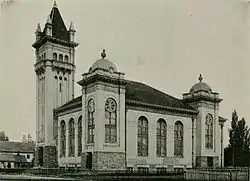Lehi Tabernacle
The Lehi Tabernacle served as a tabernacle of The Church of Jesus Christ of Latter-day Saints from its 1910 dedication to 1920 when it was sold to the Alpine School District. The building was reestablished as a tabernacle in 1937 until its eventual 1962 demolition in downtown Lehi, Utah, United States. [1]

After contributing financially to the construction of the Provo Tabernacle for many years, members of Jesus Christ of Latter-day Saints in Lehi recognized the need to construct a large meetinghouse of their own. A committee was formed who selected and secured the lot and selected the building plans of Salt Lake City architect Richard K.A. Kletting. Excavation began in February 1900.[2] On Sunday, May 15, 1910 the building was dedicated by Joseph F. Smith, then president of the Church of Jesus Christ of Latter-day Saints. The tabernacle was built with white pressed brick and the main tower extended 112 feet. The seating capacity was 1100.[3]
It was determined, by the LDS bishops in Lehi, to be a "financial burden" by 1920, and it was sold for $28,000 to the Alpine School District.[4]
It was deemed unsuitable for the stake, and was demolished in 1962 to make way for a new stake center building.[5]
References
- Bangerter, Lara M. (January 26, 2018). "Lehi Tabernacle was city's cultural hub". Retrieved 9 March 2020.
- Gardner, Hamilton (1913). History of Lehi. Salt Lake City, Ut: The Deseret News. p. 249. Retrieved 9 March 2020.
- Gardner, Hamilton (1913). History of Lehi. Salt Lake City, Ut: The Deseret News. p. 251. Retrieved 18 March 2020.
- Lara M. Bangerter (January 26, 2018). "Lehi Tabernacle was city's cultural hub". Lehi Free Press.
- Hamilton Gardner (1913). History of Lehi. The Deseret News., "Lehi Tabernacle" p.248-53.